Features of Changes in the Structure and Properties of a Porous Polymer Material with Antibacterial Activity during Biodegradation in an In Vitro Model
Abstract
1. Introduction
2. Materials and Methods
3. Result and Discussion
3.1. Wancomycin Release
3.2. Change in pH of Model Media
3.3. MIP and SEM Data
3.4. Bactericidal Activity of Vancomycin Immobilized on the Surface of the Hybrid Material Pores
3.5. Adhesion and Cell Viability on the Surface of the Porous Polymer with Antibacterial Activity (10% Vancomycin)
4. Conclusions
Author Contributions
Funding
Institutional Review Board Statement
Informed Consent Statement
Data Availability Statement
Acknowledgments
Conflicts of Interest
References
- Kovylin, R.; Aleynik, D.Y.; Fedushkin, I. Modern Porous Polymer Implants: Synthesis, Properties, and Application. Polym. Sci. Ser. C 2021, 63, 29–46. [Google Scholar] [CrossRef]
- Chesnokov, S.A.; Aleynik, D.Y.; Kovylin, R.S.; Yudin, V.V.; Egiazaryan, T.A.; Egorikhina, M.N.; Zaslavskaya, M.I.; Rubtsova, Y.P.; Gusev, S.A.; Mlyavykh, S.G. Porous Polymer Scaffolds based on Cross-Linked Poly-EGDMA and PLA: Manufacture, Antibiotics Encapsulation, and In Vitro Study. Macromol. Biosci. 2021, 21, 2000402. [Google Scholar] [CrossRef] [PubMed]
- Kwon, D.Y.; Park, J.Y.; Lee, B.Y.; Kim, M.S. Comparison of scaffolds fabricated via 3D printing and salt leaching: In vivo imaging, biodegradation, and inflammation. Polymers 2020, 12, 2210. [Google Scholar] [CrossRef] [PubMed]
- Velasco, M.A.; Narváez-Tovar, C.A.; Garzón-Alvarado, D.A. Design, materials, and mechanobiology of biodegradable scaffolds for bone tissue engineering. BioMed Res. Int. 2015, 2015, 1–21. [Google Scholar] [CrossRef] [PubMed]
- Kim, J.-A.; Lim, J.; Naren, R.; Yun, H.-s.; Park, E.K. Effect of the biodegradation rate controlled by pore structures in magnesium phosphate ceramic scaffolds on bone tissue regeneration in vivo. Acta Biomater. 2016, 44, 155–167. [Google Scholar] [CrossRef]
- Zhou, X.; Pan, Y.; Liu, R.; Luo, X.; Zeng, X.; Zhi, D.; Li, J.; Cheng, Q.; Huang, Z.; Zhang, H. Biocompatibility and biodegradation properties of polycaprolactone/polydioxanone composite scaffolds prepared by blend or co-electrospinning. J. Bioact. Compat. Polym. 2019, 34, 115–130. [Google Scholar] [CrossRef]
- Yudin, V.V.; Kovylin, R.S.; Baten’kin, M.A.; Kulikova, T.I.; Aleynik, D.Y.; Egorikhina, M.N.; Rubtsova, Y.P.; Charykova, I.N.; Mlyavykh, S.G.; Chesnokov, S.A.; et al. Visible-light induced synthesis of biocompatible porous polymers from oligocarbonatedimethacrylate (OCM-2) in the presence of dialkyl phthalates. Polymer 2020, 192, 122302. [Google Scholar] [CrossRef]
- Li, L.; Duan, Y. Engineering Polymer-Based Porous Membrane for Sustainable Lithium-Ion Battery Separators. Polymers 2023, 15, 3690. [Google Scholar] [CrossRef]
- Zhao, X.; Liu, Y.; Zhu, Q.; Gong, W. Catechol-Based Porous Organic Polymers for Effective Removal of Phenolic Pollutants from Water. Polymers 2023, 15, 2565. [Google Scholar] [CrossRef]
- Wang, H.; Wang, G.; Hu, L.; Ge, B.; Yu, X.; Deng, J. Porous Polymer Materials for CO2 Capture and Electrocatalytic Reduction. Materials 2023, 16, 1630. [Google Scholar] [CrossRef]
- Goodarzi, H.; Jadidi, K.; Pourmotabed, S.; Sharifi, E.; Aghamollaei, H. Preparation and in vitro characterization of cross-linked collagen–gelatin hydrogel using EDC/NHS for corneal tissue engineering applications. Int. J. Biol. Macromol. 2019, 126, 620–632. [Google Scholar] [CrossRef] [PubMed]
- Morozov, A.G.; Razborov, D.A.; Egiazaryan, T.A.; Baten’kin, M.A.; Aleynik, D.Y.; Egorikhina, M.N.; Rubtsova, Y.P.; Charikova, I.N.; Chesnokov, S.A.; Fedushkin, I.L. In Vitro Study of Degradation Behavior, Cytotoxicity, and Cell Adhesion of the Atactic Polylactic Acid for Biomedical Purposes. J. Polym. Environ. 2020, 28, 2652–2660. [Google Scholar] [CrossRef]
- Kim, D.-S.; Lee, J.-K.; Jung, J.-W.; Baek, S.-W.; Kim, J.H.; Heo, Y.; Kim, T.-H.; Han, D.K. Promotion of bone regeneration using bioinspired PLGA/MH/ECM scaffold combined with bioactive PDRN. Materials 2021, 14, 4149. [Google Scholar] [CrossRef]
- Hasan, R.; Wohlers, A.; Shreffler, J.; Mulinti, P.; Ostlie, H.; Schaper, C.; Brooks, B.; Brooks, A. An Antibiotic-Releasing Bone Void Filling (ABVF) Putty for the Treatment of Osteomyelitis. Materials 2020, 13, 5080. [Google Scholar] [CrossRef] [PubMed]
- Salimon, A.I.; Statnik, E.S.; Zadorozhnyy, M.Y.; Senatov, F.S.; Zherebtsov, D.D.; Safonov, A.A.; Korsunsky, A.M. Porous Open-Cell UHMWPE: Experimental study of structure and mechanical properties. Materials 2019, 12, 2195. [Google Scholar] [CrossRef]
- Pan, C.; Zhou, Z.; Yu, X. Coatings as the useful drug delivery system for the prevention of implant-related infections. J. Orthop. Surg. Res. 2018, 13, 220. [Google Scholar] [CrossRef] [PubMed]
- Pérez-Davila, S.; Potel-Alvarellos, C.; Carballo, R.; González-Rodríguez, L.; López-Álvarez, M.; Serra, J.; Díaz-Rodríguez, P.; Landín, M.; González, P. Vancomycin-Loaded 3D-Printed Polylactic Acid–Hydroxyapatite Scaffolds for Bone Tissue Engineering. Polymers 2023, 15, 4250. [Google Scholar] [PubMed]
- Šišková, B.; Kožár, M.; Staroňová, R.; Shepa, I.; Hajdučková, V.; Hudecová, P.; Kaduková, M.; Schnitzer, M. Antibacterial Effect and Therapy of Chronic Skin Defects Using the Composite Bioscaffold Polycaprolactone/GelitaSpon/Povidone-Iodine in Domestic Dogs. Polymers 2023, 15, 4201. [Google Scholar] [CrossRef]
- Stepanova, M.; Averianov, I.; Gofman, I.; Shevchenko, N.; Rubinstein, A.; Egorova, T.; Trulioff, A.; Nashchekina, Y.; Kudryavtsev, I.; Demyanova, E. Drug Loaded 3D-Printed Poly (ε-Caprolactone) Scaffolds for Local Antibacterial or Anti-Inflammatory Treatment in Bone Regeneration. Polymers 2023, 15, 3957. [Google Scholar] [CrossRef]
- Shakola, T.V.; Rubanik, V.V.; Rubanik Jr, V.V.; Kurliuk, A.V.; Kirichuk, A.A.; Tskhovrebov, A.G.; Egorov, A.R.; Kritchenkov, A.S. Benzothiazole Derivatives of Chitosan and Their Derived Nanoparticles: Synthesis and In Vitro and In Vivo Antibacterial Effects. Polymers 2023, 15, 3469. [Google Scholar] [CrossRef]
- Power, G.; Moore, Z.; O’Connor, T. Measurement of pH, exudate composition and temperature in wound healing: A systematic review. J. Wound Care 2017, 26, 381–397. [Google Scholar] [CrossRef]
- Toriseva, M.; Kähäri, V.-M. Proteinases in cutaneous wound healing. Cell. Mol. Life Sci. 2009, 66, 203–224. [Google Scholar] [CrossRef]
- Yudin, V.V.; Shurygina, M.P.; Egorikhina, M.N.; Aleynik, D.Y.; Linkova, D.D.; Charykova, I.N.; Kovylin, R.S.; Chesnokov, S.A. Pore Structure Tuning of Poly-EGDMA Biomedical Material by Varying the O-Quinone Photoinitiator. Polymers 2023, 15, 2558. [Google Scholar] [CrossRef]
- Morozov, A.G.; Markelova, E.S.; Fedyushkin, I.L. Group 2 Metal Complexes Based on Redox-Active Acenaphthene-1,2-Diimine Ligand for the Polymerization of L-Lactide. Russ. J. Appl. Chem. 2018, 91, 1044–1048. [Google Scholar] [CrossRef]
- Shin, D.-W.; Sohn, M.-J.; Cho, C.-R.; Koo, H.-w.; Yoon, S.W. Evaluation of Cumulative and Conditional Antibiotic Release from Vancomycin-Embedded Fibrin Sealant and Its Antibacterial Activity: An In Vitro Study. J. Korean Neurosurg. Soc. 2020, 63, 45. [Google Scholar] [CrossRef]
- Auñón, Á.; Esteban, J.; Doadrio, A.L.; Boiza-Sánchez, M.; Mediero, A.; Eguibar-Blázquez, D.; Cordero-Ampuero, J.; Conde, A.; Arenas, M.Á.; de-Damborenea, J.J. Staphylococcus aureus Prosthetic Joint Infection Is Prevented by a Fluorine-and Phosphorus-Doped Nanostructured Ti–6Al–4V Alloy Loaded With Gentamicin and Vancomycin. J. Orthop. Res. 2020, 38, 588–597. [Google Scholar] [CrossRef]
- Labinskaya, A.; Volina, E. Manual of medical microbiology. Gen. Sanit. Microbiol. Book. I Mosc. BINOM 2008, 1080. [Google Scholar]
- Kovylin, R.S.; Baten’kin, M.A.; Kulikova, T.I.; Egorikhina, M.N.; Charikova, I.N.; Gusev, S.A.; Rubtsova, Y.P.; Mlyavykh, S.G.; Aleynik, D.Y.; Chesnokov, S.A.; et al. Biocompatible Non-Toxic Porous Polymeric Materials Based on Carbonate- and Phthalate-Containing Dimethacrylates. ChemistrySelect 2019, 4, 4147–4155. [Google Scholar] [CrossRef]
- Bokov, A.; Bulkin, A.; Davydenko, D.; Orlinskaya, N.Y.; Egorikhina, M.; Rubtsova, Y.P.; Charykova, I.; Kovylin, R.; Yudin, V.; Chesnokov, S. Biological Response to a Novel Hybrid Polyoligomer: In vitro and in vivo Models. Sovrem. Teh. v Med. 2020, 12, 36–44. [Google Scholar] [CrossRef]
- Lim, H.-A.; Raku, T.; Tokiwa, Y. Hydrolysis of polyesters by serine proteases. Biotechnol. Lett. 2005, 27, 459–464. [Google Scholar] [CrossRef]
- Gorrasi, G.; Pantani, R. Hydrolysis and Biodegradation of Poly (lactic acid). In Synthesis, Structure and Properties of Poly(lactic acid); Di Lorenzo, M.L., Androsch, R., Eds.; Springer International Publishing: Cham, Switzerland, 2018; pp. 119–151. [Google Scholar]
- Munakata, C.; Fuchigami, Y.; Makizoe, N.; Miura, Y.; Yamaoka, M.; Sasahara, S.; Hata, K.; Tachiki, H.; Sasaki, H.; Hagimori, M. Effect of pH and Additives on the Compatibility between Vancomycin and Furosemide Injections. Yakugaku Zasshi 2018, 138, 853–860. [Google Scholar] [CrossRef]
- Metsemakers, W.-J.; Fragomen, A.T.; Moriarty, T.F.; Morgenstern, M.; Egol, K.A.; Zalavras, C.; Obremskey, W.T.; Raschke, M.; McNally, M.A. Evidence-based recommendations for local antimicrobial strategies and dead space management in fracture-related infection. J. Orthop. Trauma. 2020, 34, 18. [Google Scholar] [CrossRef]
- Strachunsky, L.; Kozlov, S. Modern antimicrobial chemotherapy. A guide for doctors. M. Borges 2002, 432. [Google Scholar]
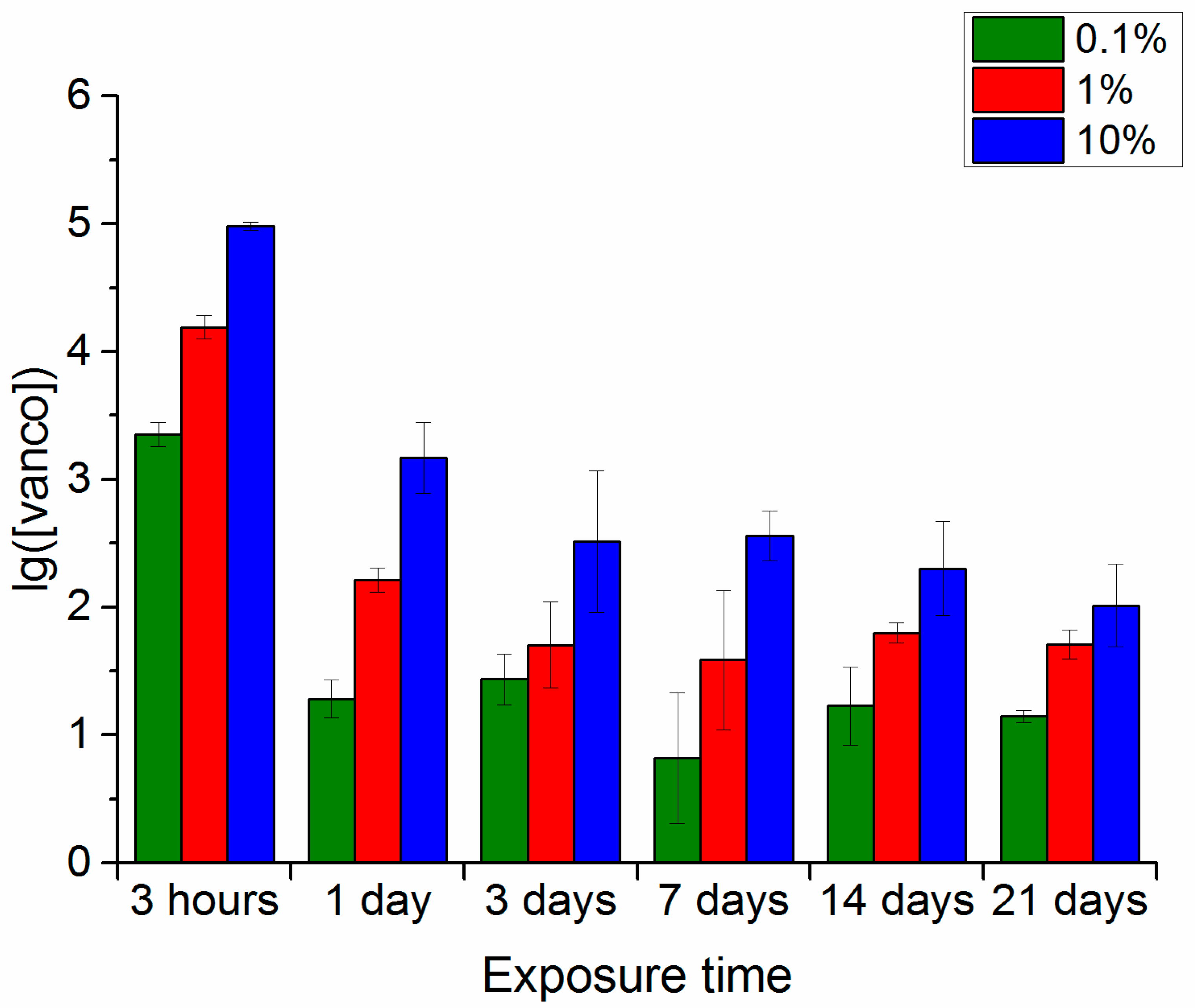
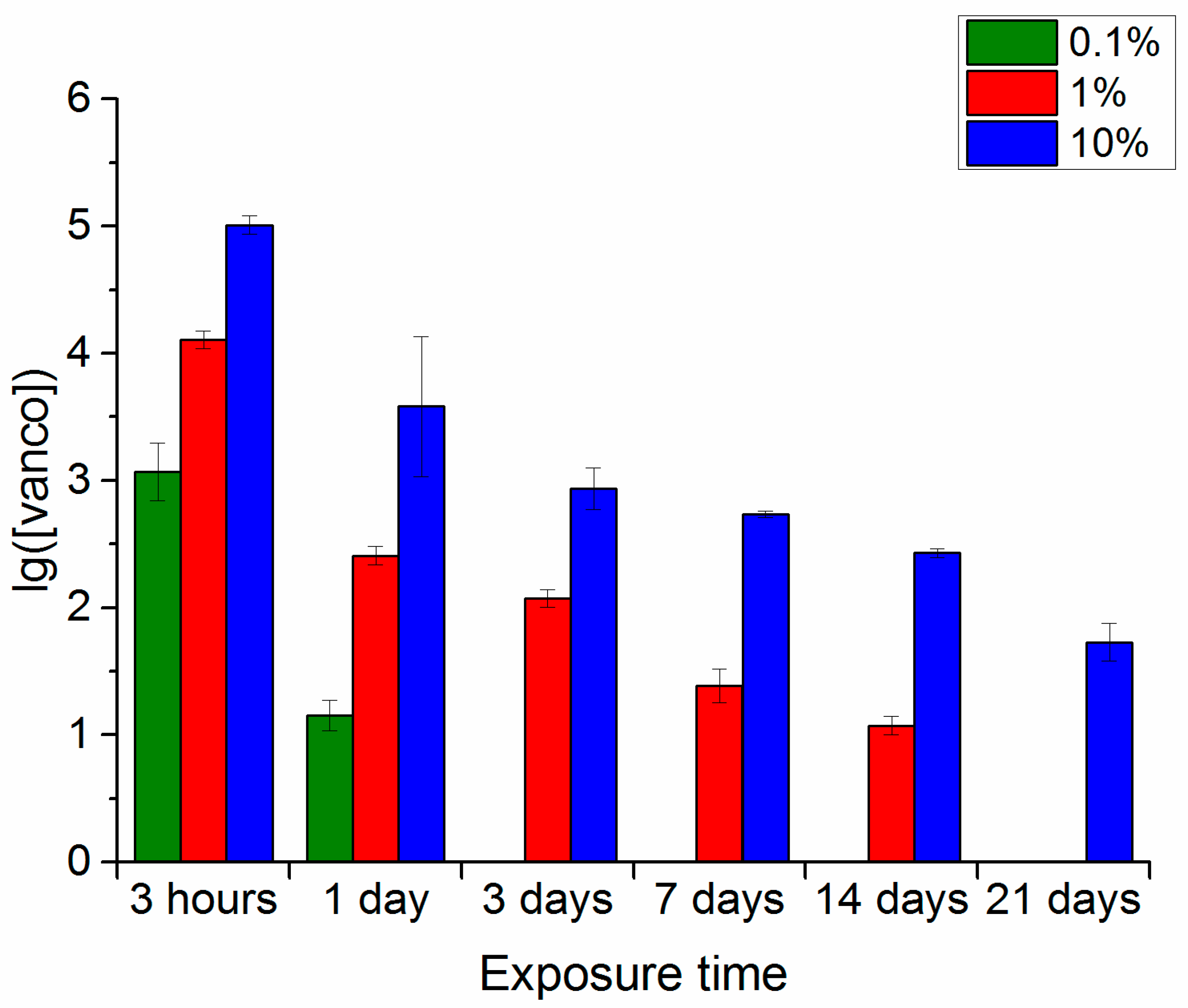
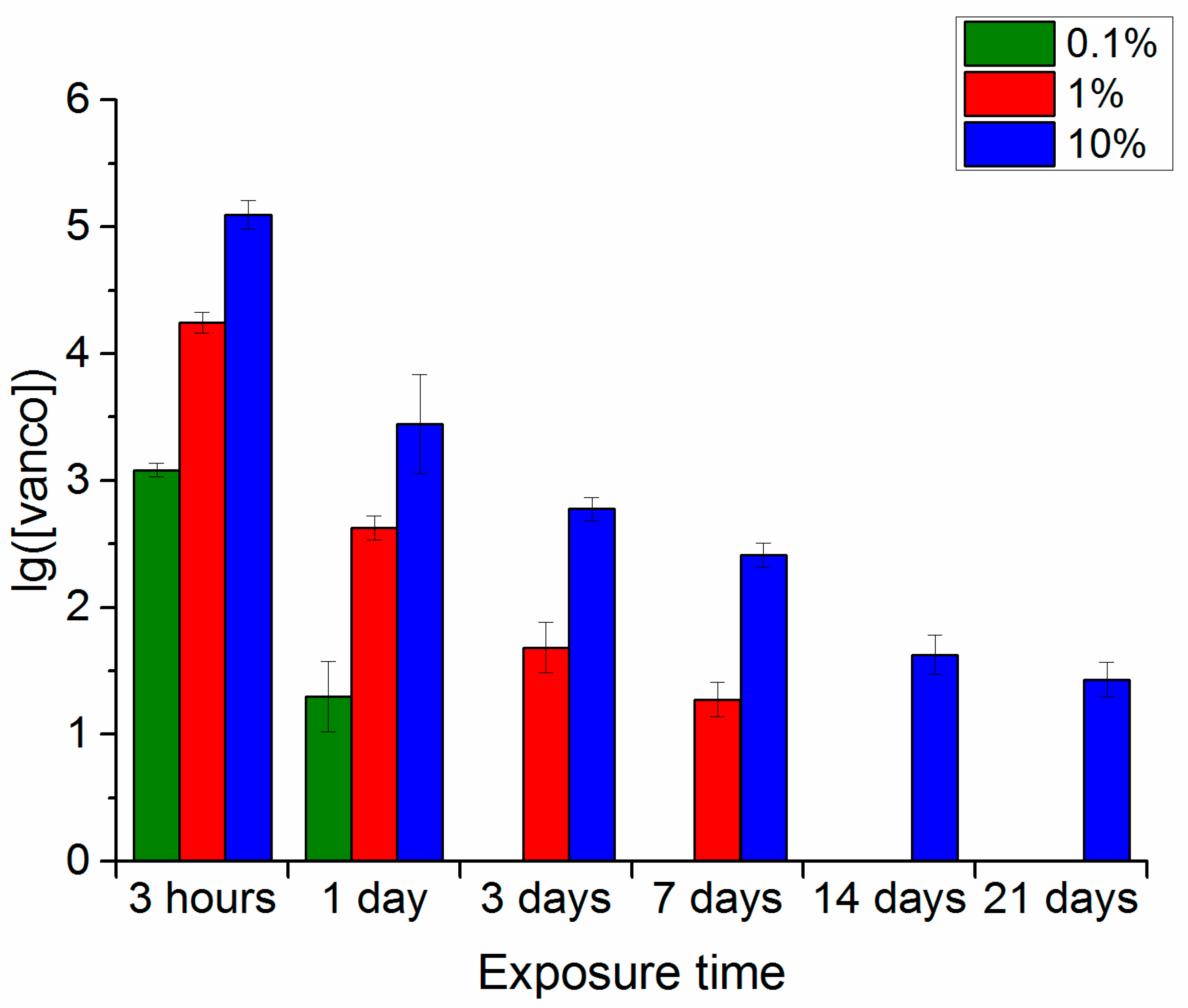
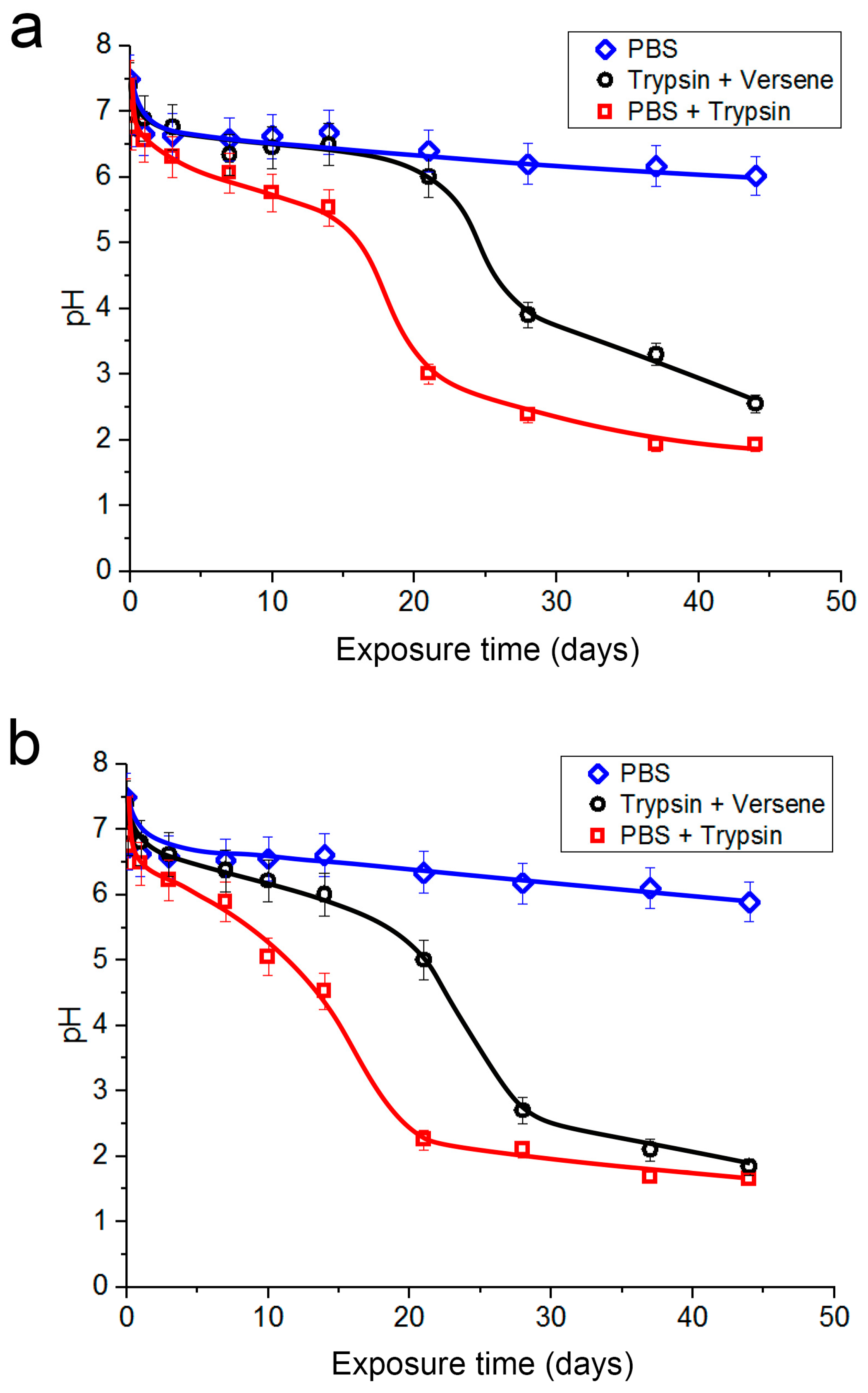
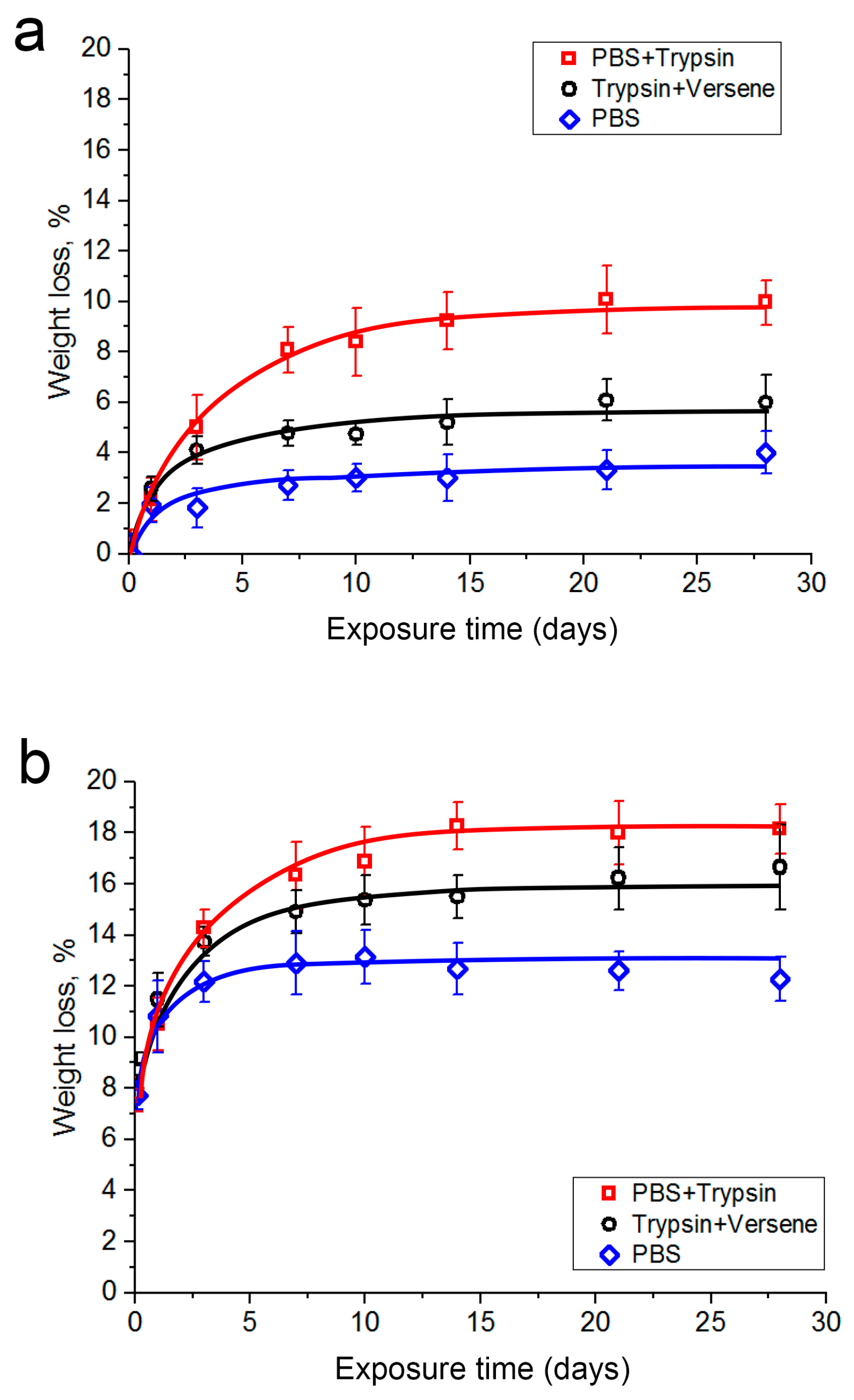
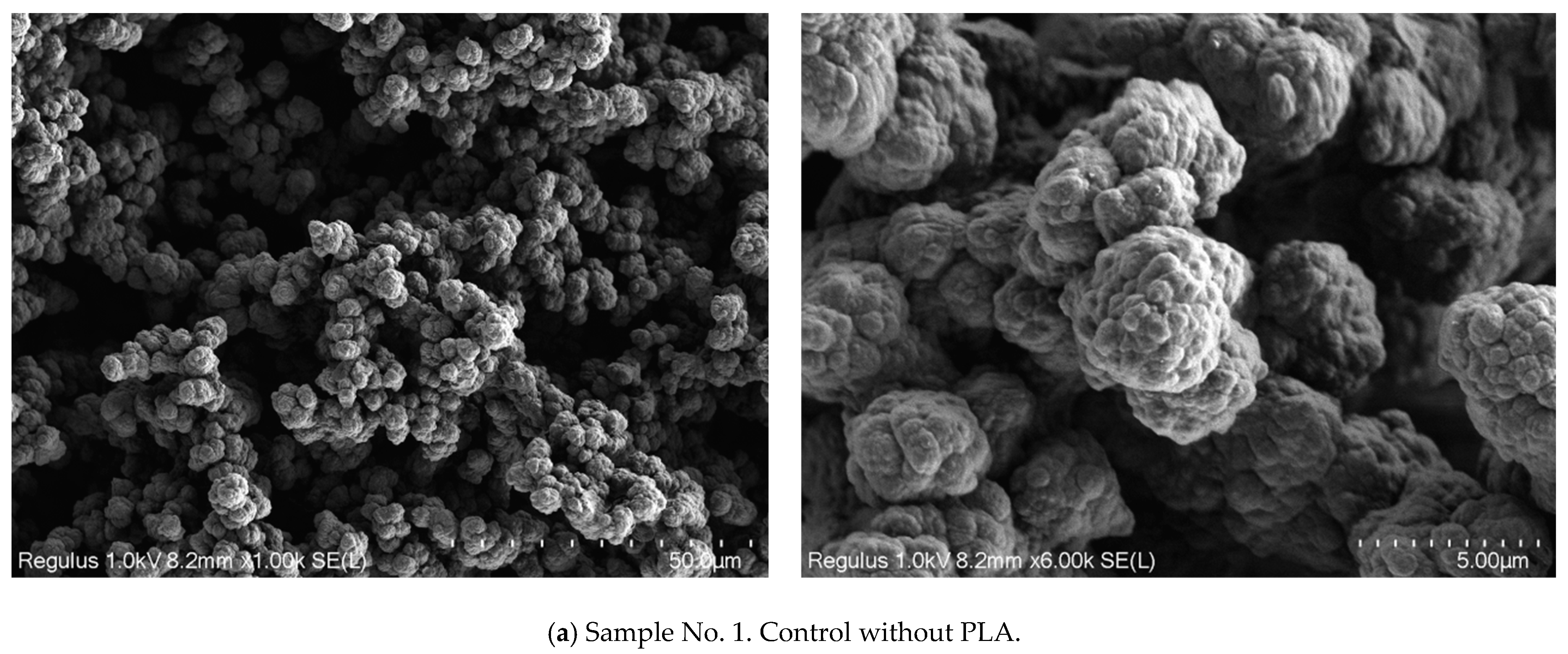
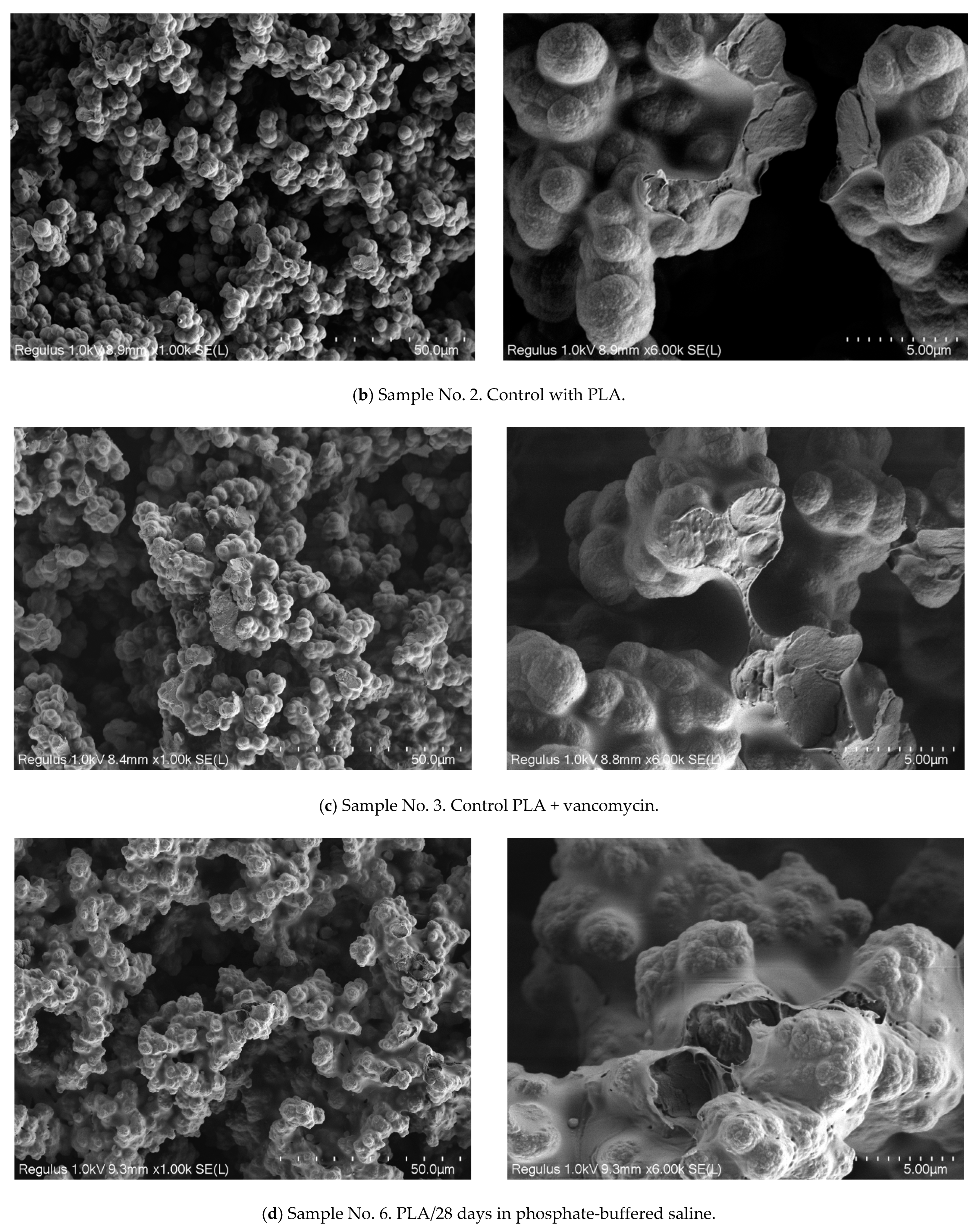
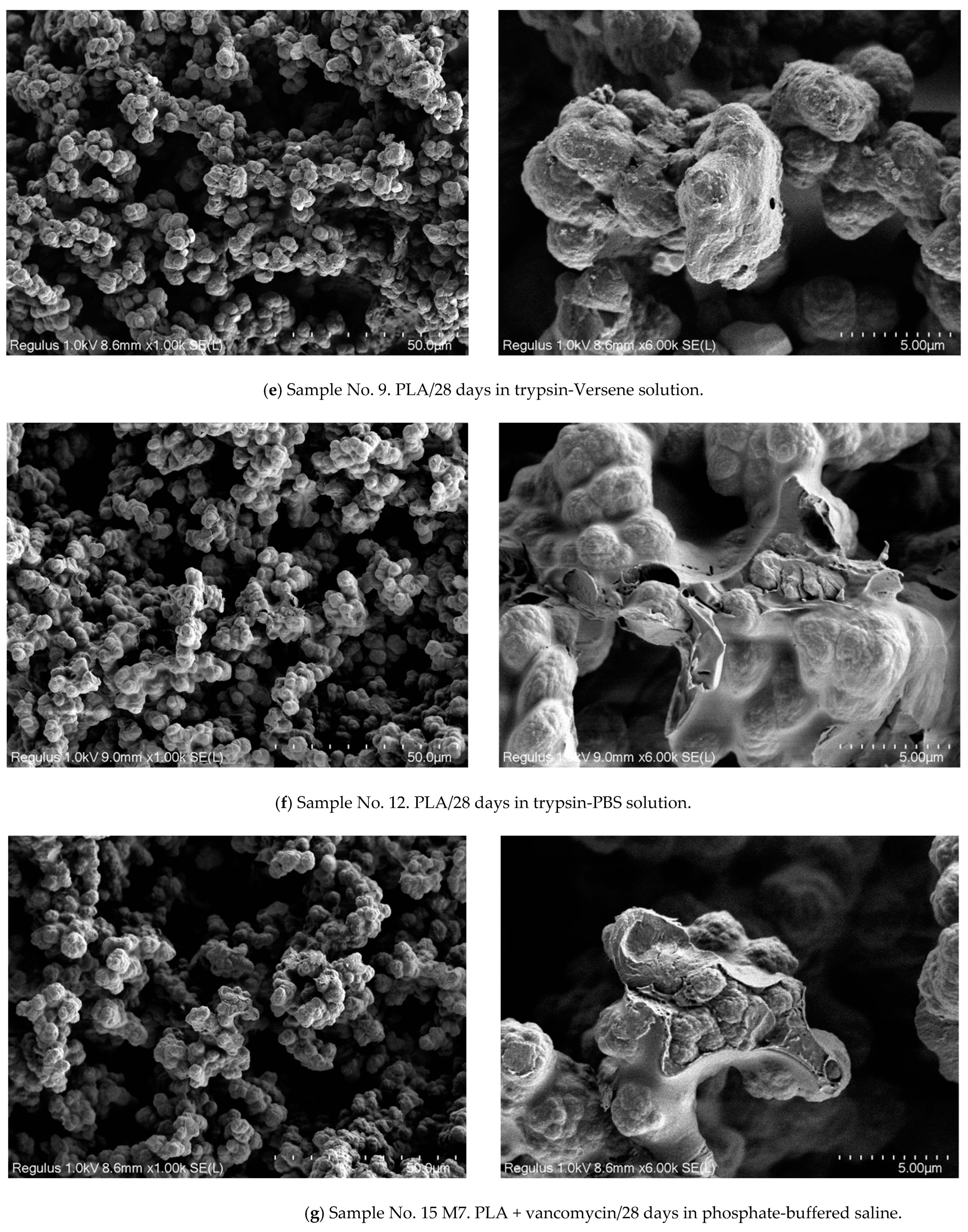
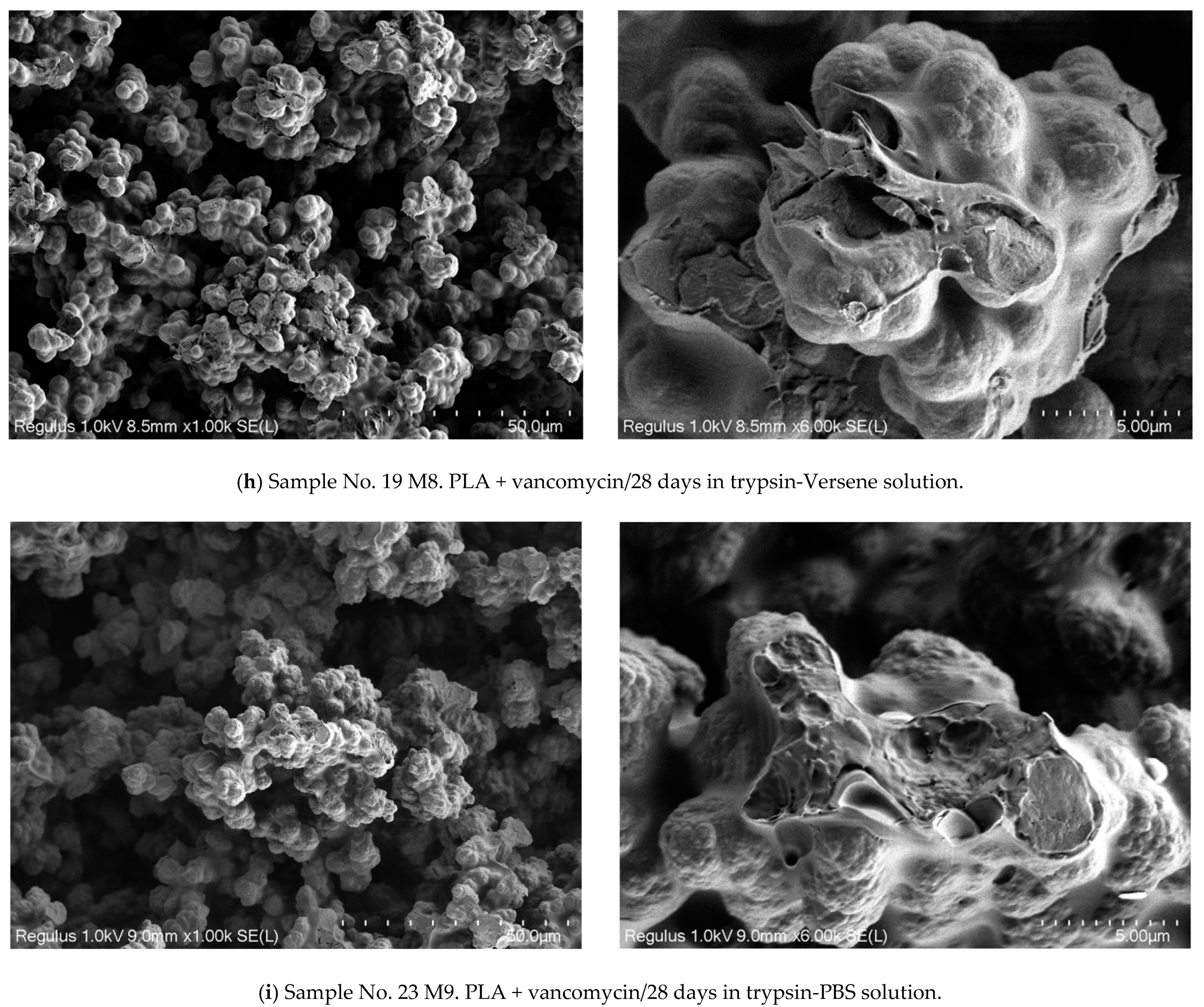
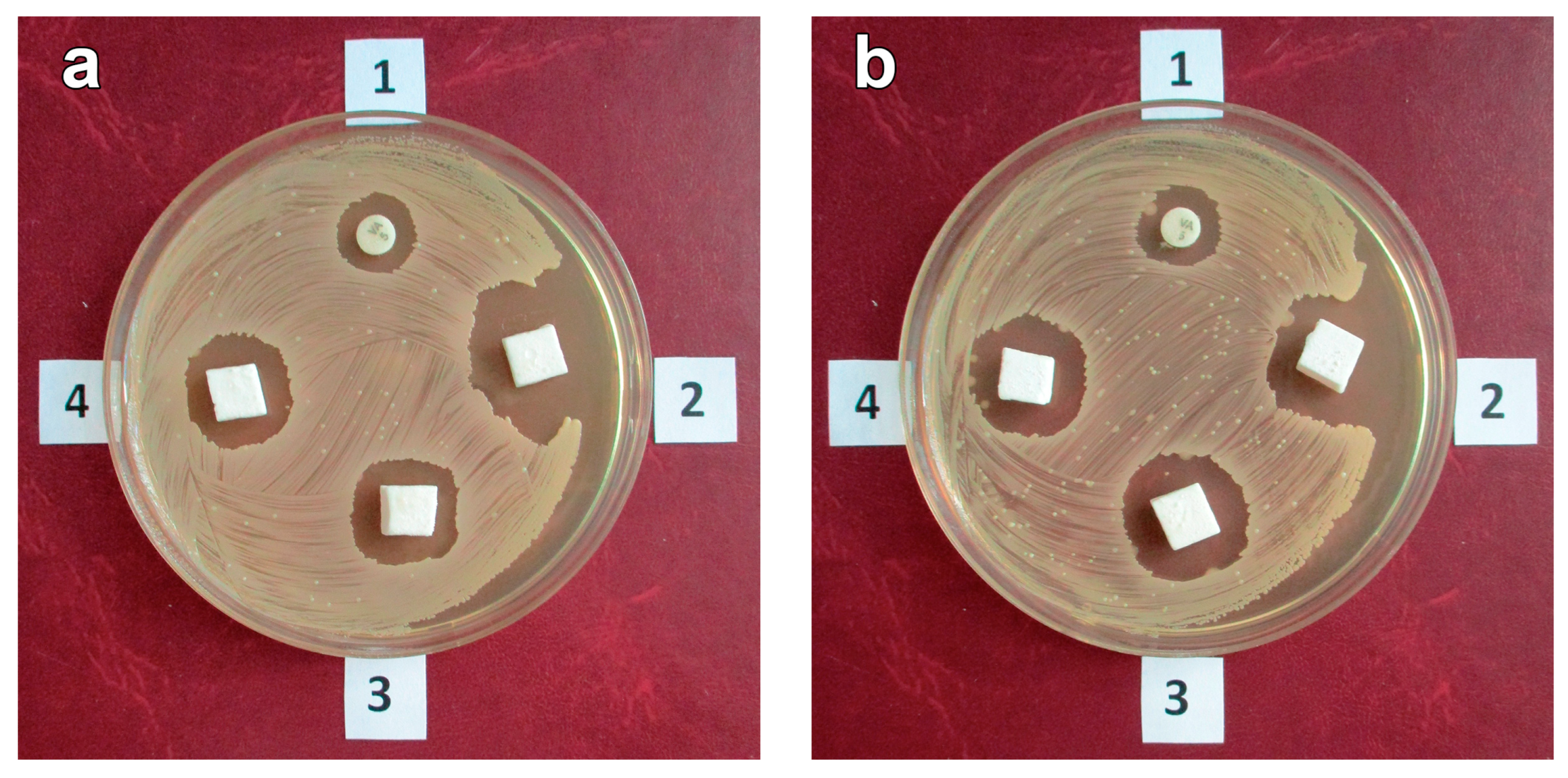


| № | Conditions | Time, Days | Dmod, μm | ε, % | |
|---|---|---|---|---|---|
| 1 | Control without PLA | 0 | 9.3 | 69.55 | |
| 2 | Control with PLA | 0 | 11.0 | 57.97 | |
| 3 | Control with PLA + vancomycin | 0 | 9.8 | 54.56 | |
| 4 | PLA | PBS | 0.125 | 11.0 | 62.03 |
| 5 | PLA | PBS | 21 | 9.8 | 58.12 |
| 6 | PLA | PBS | 28 | 11.7 | 59.10 |
| 7 | PLA | Trypsin + Versene | 0.125 | 10.4 | 57.17 |
| 8 | PLA | Trypsin + Versene | 21 | 11.2 | 61.88 |
| 9 | PLA | Trypsin + Versene | 28 | 10.7 | 59.35 |
| 10 | PLA | Trypsin + PBS | 0.125 | 11.0 | 61.53 |
| 11 | PLA | Trypsin + PBS | 21 | 11.2 | 64.28 |
| 12 | PLA | Trypsin + PBS | 28 | 11.3 | 63.49 |
| 13 | PLA + vancomycin | PBS | 0.125 | 9.5 | 62.25 |
| 14 | PLA + vancomycin | PBS | 21 | 9.5 | 62.70 |
| 15 | PLA + vancomycin | PBS | 28 | 10.8 | 60.27 |
| 16 | PLA + vancomycin | PBS | 56 | 9.5 | 57.23 |
| 17 | PLA + vancomycin | Trypsin + Versene | 0.125 | 9.8 | 61.58 |
| 18 | PLA + vancomycin | Trypsin + Versene | 21 | 9.5 | 61.67 |
| 19 | PLA + vancomycin | Trypsin + Versene | 28 | 10.3 | 61.32 |
| 20 | PLA + vancomycin | Trypsin + Versene | 56 | 10.5 | 60.66 |
| 21 | PLA + vancomycin | Trypsin + PBS | 0.125 | 11.5 | 59.63 |
| 22 | PLA + vancomycin | Trypsin + PBS | 21 | 11.2 | 56.94 |
| 23 | PLA + vancomycin | Trypsin + PBS | 28 | 9.4 | 59.97 |
| 24 | PLA + vancomycin | Trypsin + PBS | 56 | 10.7 | 67.35 |
Disclaimer/Publisher’s Note: The statements, opinions and data contained in all publications are solely those of the individual author(s) and contributor(s) and not of MDPI and/or the editor(s). MDPI and/or the editor(s) disclaim responsibility for any injury to people or property resulting from any ideas, methods, instructions or products referred to in the content. |
© 2024 by the authors. Licensee MDPI, Basel, Switzerland. This article is an open access article distributed under the terms and conditions of the Creative Commons Attribution (CC BY) license (https://creativecommons.org/licenses/by/4.0/).
Share and Cite
Yudin, V.V.; Kulikova, T.I.; Morozov, A.G.; Egorikhina, M.N.; Rubtsova, Y.P.; Charykova, I.N.; Linkova, D.D.; Zaslavskaya, M.I.; Farafontova, E.A.; Kovylin, R.S.; et al. Features of Changes in the Structure and Properties of a Porous Polymer Material with Antibacterial Activity during Biodegradation in an In Vitro Model. Polymers 2024, 16, 379. https://doi.org/10.3390/polym16030379
Yudin VV, Kulikova TI, Morozov AG, Egorikhina MN, Rubtsova YP, Charykova IN, Linkova DD, Zaslavskaya MI, Farafontova EA, Kovylin RS, et al. Features of Changes in the Structure and Properties of a Porous Polymer Material with Antibacterial Activity during Biodegradation in an In Vitro Model. Polymers. 2024; 16(3):379. https://doi.org/10.3390/polym16030379
Chicago/Turabian StyleYudin, Vladimir V., Tatyana I. Kulikova, Alexander G. Morozov, Marfa N. Egorikhina, Yulia P. Rubtsova, Irina N. Charykova, Daria D. Linkova, Maya I. Zaslavskaya, Ekaterina A. Farafontova, Roman S. Kovylin, and et al. 2024. "Features of Changes in the Structure and Properties of a Porous Polymer Material with Antibacterial Activity during Biodegradation in an In Vitro Model" Polymers 16, no. 3: 379. https://doi.org/10.3390/polym16030379
APA StyleYudin, V. V., Kulikova, T. I., Morozov, A. G., Egorikhina, M. N., Rubtsova, Y. P., Charykova, I. N., Linkova, D. D., Zaslavskaya, M. I., Farafontova, E. A., Kovylin, R. S., Aleinik, D. Y., & Chesnokov, S. A. (2024). Features of Changes in the Structure and Properties of a Porous Polymer Material with Antibacterial Activity during Biodegradation in an In Vitro Model. Polymers, 16(3), 379. https://doi.org/10.3390/polym16030379









